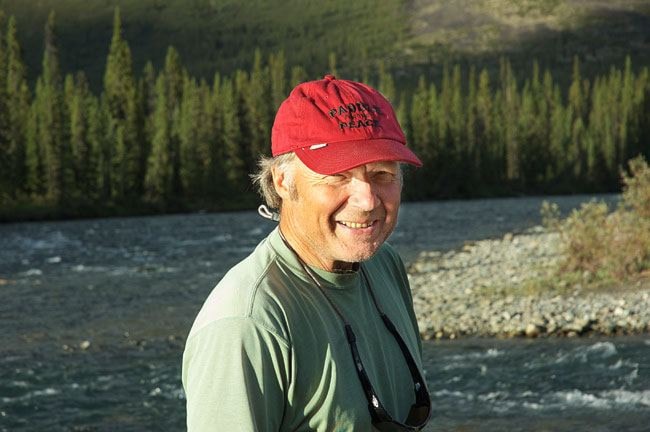When Juri Peepre was a boy, he spent his spare time in the sugar bushes and forests of southern Ontario.
“I remember wandering around in the fields and forests around Guelph,” Peepre recalls.
“I was always very concerned when those sugar bushes were chopped down one by one.”
That concern for Guelph’s maple trees and green spaces grew as Peepre did, leading him to a life of conservation and now, most recently, to membership in the Order of Canada.
Peepre was named to the order, along with 90 other Canadians, earlier this month for his work protecting Canadian wilderness for future generations.
He has worked on conservation initiatives across Western Canada, but one of his most abiding legacies is the Yukon chapter of the Canadian Parks and Wilderness Society, and its campaign to protect the Peel Watershed.
Peepre helped start the Yukon chapter when he and his wife moved to the territory in the late 1980s.
“I had been working in conservation in government with Parks Canada and through the Wild Rivers survey in Northern B.C. My wife, Sarah Locke, got a job offer with CBC in the Yukon, so we moved up here,” he said.
“A bunch of us got together and thought it’d be great to have a conservation organization. The Yukon Conservation Society had already been a very strong voice, but at that time we felt that it was important to have an additional voice around the table on protected areas. The CPAWS mission was to advocate for protected areas and parks.
“The feeling was that we were part of a very exciting national campaign called the endangered spaces campaign. The objective was to complete a network of protected spaces, province by province, across the country,” Peepre said.
Once the Yukon chapter was up and running, it started looking at how best to accomplish its goals. One way was to help support Yukon First Nations in their negotiations for land claim settlements, Peepre said.
“Land claims were drawing to a close, but there was still an opportunity to establish many more protected areas through First Nations that were still in a negotiation stage. Absolutely we were in support of First Nations in conservation initiatives.”
One of the organization’s biggest successes was helping to establish Tombstone Territorial Park on the Dempster Highway.
But perhaps the biggest battle for CPAWS is still being fought.
“Our other effort was the Peel Watershed campaign. That started off as the Three Rivers Campaign, but we were always very mindful of the need to protect the entire region,” Peepre said.
Peepre was the CPAWS Yukon executive director until 2004. He was there when the start of the Peel land use planning process first got underway. Having watched the process unfold, he said he was at first hopeful, but is now frustrated.
When the process began, it was carried out under the Umbrella Final Agreement, which outlines how the government must consult and accommodate First Nations affected by land use planning.
The after years of work, the Peel Watershed Land Use Planning Council released its final recommended plan, which called for 80 per cent protection for the Peel Watershed.
But at the eleventh hour in the process, the government released its own set of possible plans, which many critics say run afoul of the work done by the planning commission.
“The government has been cynical and stubborn in its treatment of that plan. It has ignored the whole segment of civil society that wants to see that area protected. I can’t really read the tea leaves, but the governments record on this is troubling,” Peepre said.
He knows of what he speaks. Now based in B.C.‘s Kootenays, Peepre currently works as a project manager for the Yellowstone to Yukon Conservation Initiative. That organization is seeking to establish an unbroken wilderness corridor for endangered animals to roam freely from the Yellowstone National Park in the U.S. to all the way to Yukon.
Much of Peepre’s work now focuses on ensuring what little land is left protected in the Kootenays stays that way, and he worries that area might be a harbinger for Yukon things to come.
“In B.C., we’re in a different situation. Much of the Yukon is a beautiful, intact wilderness with creeping issues of resource development. Here we’re really trying to hold together the remaining wild places.
“They’re protected, but they’re not linked. They are under pressure from mining, logging - a variety of different issues. It’s a beautiful landscape here but it’s seriously fragmented. It’s what I hope the Yukon doesn’t become,” he said.
It’s no stretch to say that Peepre has dedicated his life to Canada’s wilderness, and no one knows this better than CPAWS Yukon’s current president and Peepre’s longtime friend, Jill Pangman.
“Juri, he understands the need for preserving it. He has spent a lifetime exploring wild places, through ski touring, paddling, hiking. Because he has such a close personal experience he understands how important it is. That’s been his own passion in life, being out here in wild places,” she said.
For Pangman, Peepre’s induction to the order is recognition not only of his work but of the value of conservation, and its importance to all Canadians.
“I think it’s really important,” she said. “So often, we’re so myopic about our own self-importance. It’s often at these high, prestigious levels; conservation and wilderness preservation is not something that is often honoured by the Order of Canada.
The fact that it was is a huge showing.”
As for Peepre himself, he’s just humbled to have been nominated at all.
“It was a big surprise. I’m very honoured by it, but I also realize that there are hundreds of other people who are working on conservation, and this is for them as well,” he said.
Contact Jesse Winter at
jessew@yukon-news.com
